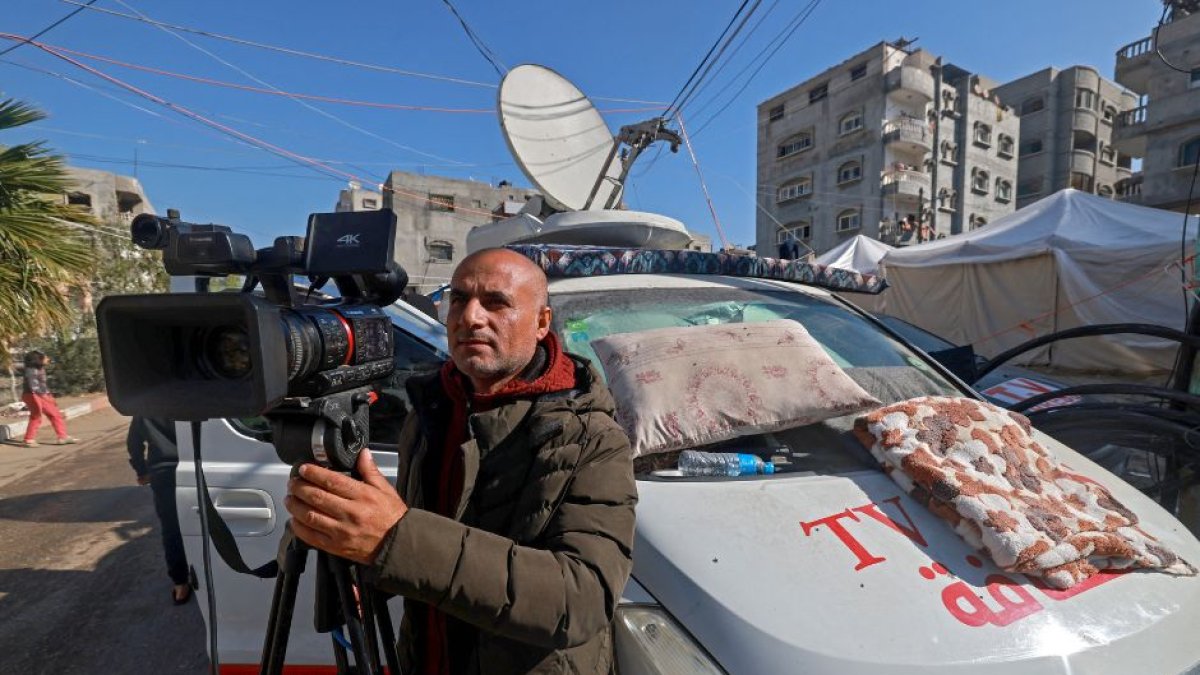How does Hamas put together the story that the international press buys?
Fake news, incomplete data on deaths, a strikingly small number of terrorists who die in combat, records that are modified without explanation and dubious sources are all part of the Hamas narrative that the media spreads.

Un periodista trabaja afuera de su vehículo cerca de un refugio improvisado en Rafah, en el sur de la Franja de Gaza, el 11 de diciembre de 2023, en medio de continuas batallas entre Israel y el grupo terrorista Hamás.
The war in Gaza, like any other modern conflict of its type, is not only fought on the battlefield, but also in the press. On the one hand, there is Israel, the only democracy in the Middle East, where in addition to the data provided by official authorities, various media and non-governmental organizations are able to work freely to report on what is happening there. On the other side is Hamas, the terrorist and authoritarian organization that rules in Gaza, where there is no freedom of expression and all the information that comes out of the strip is provided by the Islamist group.
In a nutshell: on one side, all the eyes in the world are watching, including Israel's, since the government must be permanently accountable in a country where a democracy with division of powers governs. On the other side is Hamas' story and only Hamas' story.
Data on the war coming out of Gaza is officially managed by the Gaza Strip's Ministry of Health, run by Hamas, and all information provided by the terrorist group is published by the international press. However, health authorities indicated on April 6 that they had “incomplete data” on 11,371 of the 33,091 deaths the terrorist organization claimed to have documented.
The ministry explained in a report that it considers an individual record to be incomplete when the identification number, full name, date of birth or date of death is missing, ergo when the person in question's basic information is not there.
The Ministry of Health also published a report on April 3 that acknowledged the presence of incomplete data but did not define what it meant by “incomplete.” In that report, the ministry admitted that key information was missing for 12,263 records. However, three days later, that number was reduced to 11,371, although health authorities did not explain how this significant decrease occurred.
Another important issue to consider is how the Hamas-led Ministry of Health obtains information. In fact, before admitting the issue related to incomplete data, health authorities in the Gaza Strip maintained that more than 15,000 death records came from “reliable media sources.” However, the ministry did not clarify which sources it was referring to, a fact that is not insignificant, especially considering that there are no independent media outlets in Gaza.
According to David Adesnik, senior fellow and research director at the Foundation for Defense for Democracies (FDD), “The sudden shifts in the ministry’s reporting methods suggest it is scrambling to prevent exposure of its shoddy work.”
Adesnik also criticized the way in which the United States press has disseminated the information provided by Hamas. “For months, U.S. media have taken for granted that the ministry’s top-line figure for casualties was reliable enough to include in daily updates on the war. Even President Biden has cited its numbers. Now we’re seeing that a third or more of the ministry’s data may be incomplete at best — and fictional at worst,” he maintained.
Another important point to take into account regarding the information provided by the Gaza Ministry of Health is linked to the apparent omission of data related to the number of Palestinian terrorists who have been killed in combat. Joe Truzman, senior research analyst at news site Long War Journal, run by the FDD, stated, “It is important to recognize that Hamas is deeply invested in shaping the narrative that emerges from Gaza, particularly regarding the number of casualties in the war.” He added, “Moreover, this control of data extends beyond the statistics provided by the Hamas-controlled health ministry, as there is also a deliberate effort to downplay the number of terrorists who have been killed by Israel in the war, potentially numbering more than 10,000.”
Fake news: Hamas' strategy to build its own narrative
One of Hamas' most grotesque false reports was spread by the terrorist group in the initial days of the war, when on Oct. 16, the Gaza Ministry of Health told the global media that 500 Palestinians had been killed in an Israeli airstrike at Al-Ahli Hospital, in the northern Gaza Strip. The international press rushed to publish the news, taking the information provided by the terrorist group at face value, even though there was no evidence to support it. In fact, a few hours later it was proven that the incident had actually occurred due to a rocket misfired by the Islamic Jihad terrorist group in the hospital parking lot, which according to a U.S. intelligence report, caused between 100 and 300 deaths.
It is also important to highlight that the Israel Defense Forces reported that 12% of the rockets (around 1,000) launched by terrorists towards the Jewish state during the first month of the war fell in the Gaza Strip.
Israel took responsibility for and investigated its mistakes
In contrast with Hamas, the IDF has immediately acknowledged the mistakes made during the war, apologized, investigated, and taken strong measures in an attempt to prevent them from happening again in the future.
One of the most notable cases occurred in early April, when seven humanitarian workers died after the IDF mistakenly bombed vehicles belonging to the NGO World Central Kitchen (WCK), in charge of distributing food in areas stricken by natural disasters and armed conflict. According to the investigation, the tragic event occurred as a result of a identification error by Israeli forces. “The investigation found that the forces identified a gunman on one of the aid trucks, following which they identified an additional gunman. ... After the vehicles left the warehouse where the aid had been unloaded, one of the commanders mistakenly assumed that the gunmen were located inside the accompanying vehicles and that these were Hamas terrorists," the IDF reported.
The IDF claimed that the attacks on the three vehicles constituted a “serious violation of orders and standard operating procedures,” which is why they decided that "the brigade fire support commander, an officer with the rank of major, will be dismissed from his position. The brigade chief of staff, an officer with the rank of colonel in reserve, will be dismissed from his position. Additionally, the brigade commander and the 162nd Division commander will be formally reprimanded."
The Israeli Army also expressed its “deep sorrow for the loss” of the workers and also added: “[We] send our condolences to the families and the WCK organization. We consider the vital humanitarian activity of international aid organizations to be of utmost importance, and we will continue to work to coordinate and assist their activities, while ensuring their safety and safeguarding their lives.”
Another serious mistake made by the IDF occurred in mid-December, when Israeli soldiers killed three hostages who were being held by Hamas in Gaza, mistaking them for Palestinian terrorists. The IDF carried out a corresponding investigation, took action and sent its condolences to the families.
Al Jazeera collaborates in Hamas' disinformation campaign
At the end of March, Qatari news network Al Jazeera decided to retract and delete a series of articles that accused the Israel Defense Forces of committing sexual abuse at Al-Shifa Hospital in Gaza.
The controversy gained wide circulation after Al Jazeera published the testimony of a woman who claimed to have witnessed the rape of Palestinian women inside the Gazan hospital.
The Qatari media deleted the stories shortly after without adding many more details. The report was, however, picked up by many other media. In her testimony, the Palestinian woman claimed that IDF soldiers threw the bodies of mutilated women to their dogs, among other gory descriptions of violence.
A former Al Jazeera director made some clarifications through a post on social media. Abu Hilalah, who served as part of the leadership team for the Qatari state-owned outlet, assured that the story published by Al Jazeera was not true. Without citing sources, the manager added that the woman who gave her testimony ended up confessing that the story was fabricated.
This fake news led, strikingly, to several pro-Palestinian media outlets and influencers, such as Sulaiman Ahmed, who say they doubt the rape of women by Hamas terrorists during the Oct. 7 massacre, to immediately believe this fake story, which they spread without hesitation as if it were real.
Al Jazeera has also reported other fake news, such as the bombing of an Orthodox church in Gaza and the murder of two Christian women in a Catholic church in the Gaza Strip by Israeli snipers. These two pieces of information were disseminated without any type of evidence and have already been denied by the IDF and various media sources.
The Qatari news network has also been under fire because many of its employees have been accused of participating in terrorist acts against Israel. One of the most notable cases was that of the reporter Hamza al-Dahdouh and cameraman Mustafa Thuraya, who were killed in an Israeli airstrike while traveling in a vehicle from Khan Younis to Rafah. As expected, Al Jazeera condemned the strike. Hamas announced Dahdouh's death and added his name to a list of journalists allegedly killed in the war. However, the IDF stated days later that the vehicle was bombed because both reporters were operating a drone that posed a threat to Israeli soldiers near Rafah. Later, the IDF added that Dahdouh was an agent of the Electronic Engineering Unit and a regional official of the Palestinian Islamic Jihad Rocket Unit. Al Jazeera rejected the Israeli accusation and condemned “attempts to justify the killing of our colleague Hamza Wael Dahdouh and other journalists.”
The IDF indicated that the other reporter who died in the offensive, cameraman Mustafa Thuraya, was the one who operated the drone and who appeared on a list of terrorists fighting for Hamas' Al-Qadisiya Battalion.

























